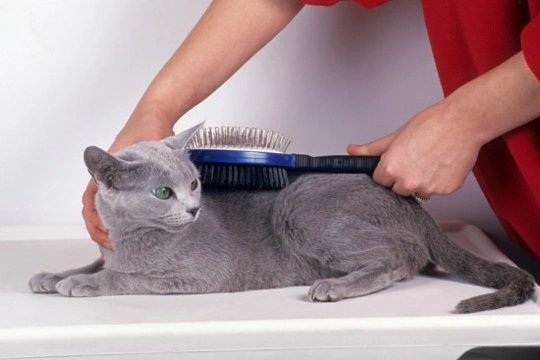
Grooming Your Cat
All cats need regular grooming, although the coats of longhaired varieties will need far more attention than those of their shorter coated friends. Cats are naturally very clean animals and seem to enjoy having a good wash, but the build-up of loose hair can lead to fur balls, even with shorthaired cats, which in the worst instance can sometimes block the intestinal area if they are unable to be expelled. Your cat will probably enjoy the extra attention from you, and it is a good idea to get them used to being groomed whilst they are still kittens if possible. And whilst you're grooming your cat, you will also be able to check for any visible signs of fleas or parasites.
With shorthaired cats, you can use a rubber brush with quite chunky rubber bristles that you should be able to get from a pet store, although you may need to be a little bit careful that you don't remove too much hair! It's probably best to use this once every 1-2 weeks, and then in between times, if you stroke your cat with damp hands until the fur is dry, you will be able to remove any stray loose hairs.
Longhaired varieties need grooming every day, otherwise their coats can quickly become tangled or even matted, and then it can become almost impossible to deal with the knotted hair apart from cutting out the tangles. But if you groom them every day using a wide-toothed metal comb and a natural bristle brush (nylon brushes tend to set up static electricity), then you shouldn't have any problems. Longhaired cats usually have thicker coats in winter, which retain water for longer if they go out, and you will need to let them dry out complete before even attempting to brush and comb them.
It's not usual to need to bath a cat at all, but if a situation arises when it is necessary, use a specially formulated shampoo for cats, or else a very weak solution of a mild baby shampoo. It's often easier to stand the cat next to a bowl of water in this situation, rather than trying to persuade them to stand in a bath, and you will need lots of towels at the ready, as well as another pair of helping hands if possible. You can use a hairdryer to dry the coat afterwards, but put it on the lowest possible setting and stop immediately if your cat is frightened by it. If your cat has somehow got covered in a noxious substance such as oil, you should take them to your Vet immediately as the substance itself could well be poisonous to cats, and any solutions manufactured for grimy human hands will almost certainly harm your cat.
Besides looking after your cat's coat, you should also check their ears (including looking for possible mites) as well as their eyes and noses. Rex-coated and sphynx cats with few, if any, guard hairs around their faces, will need to have their ears checked for excessive wax build-up and general dirt or foreign objects. Longhaired cats sometimes get a clear, slightly sticky, discharge from their eyes, and this can be wiped away using cotton wool and either a preparatory cleaner that is specifically designed for the purpose from a pet store, or else a very weak saline solution using warm water. Some shorthaired cats, and especially those with paler-colour coats, also get a build-up of dark dirt in the corner of their eyes and this can be dealt with in exactly the same way.
Some cats (usually, but not always, younger 'entire' cats rather than neuters) develop greasy black spots on their faces and chins, and sometimes on their tails, which is known as 'feline acne'. Your Vet may be able to suggest a special treatment for this if it is very bad, although quite often a mild treatment intended for human teenagers will do the job. As with humans, stop the treatment immediately if you notice any allergic reaction to the solutions being used.
Outdoor cats will usually 'strop' their claws on trees and plants to keep the length down, but those who live mainly inside may need their claws trimming if they do not use a scratching post. This is especially true for older cats that cannot retract their claws as well as they could when they were younger, and if left unchecked, the claws could grow round into their paw pads. Cats' claws are quite tough, and you will need to buy a special pair of trimmers from your Vet or a pet store - ordinary scissors or human nail clippers won't be up to the job. If you get you cat used to this as soon as they come to live with you, they probably won't mind too much - although it's often easier to get someone to hold your cat so that you can concentrate on the job in hand! All you need to trim is the actual tip of the claw - take care you don't go down into the pink 'quick' within the claw, otherwise this will hurt your cat and will cause them to bleed.



